When you're out on the road, the last thing you want is to deal with electrical issues on your motorcycle. Common problems like battery failures, wiring harness issues, and faulty voltage regulators can really put a damper on your ride. You might notice symptoms such as flickering lights or difficulty starting, which could signal deeper troubles. Ignoring these signs can lead to unsafe conditions, so it's essential to understand what to look for and how to address these concerns effectively. Let's explore some of these common electrical issues and how they can impact your riding experience.
Key Takeaways
- Battery failures often manifest as difficulty starting and dim lights, necessitating regular checks for corrosion and connections.
- Wiring harness issues, including corrosion and loose connections, can lead to flickering lights and complete electrical failure.
- Faulty voltage regulators cause inconsistent electrical performance, with symptoms like dim lights and drained batteries.
- Starter motor problems arise from weak batteries or faulty relays, hindering engine starting capabilities.
Battery Failures
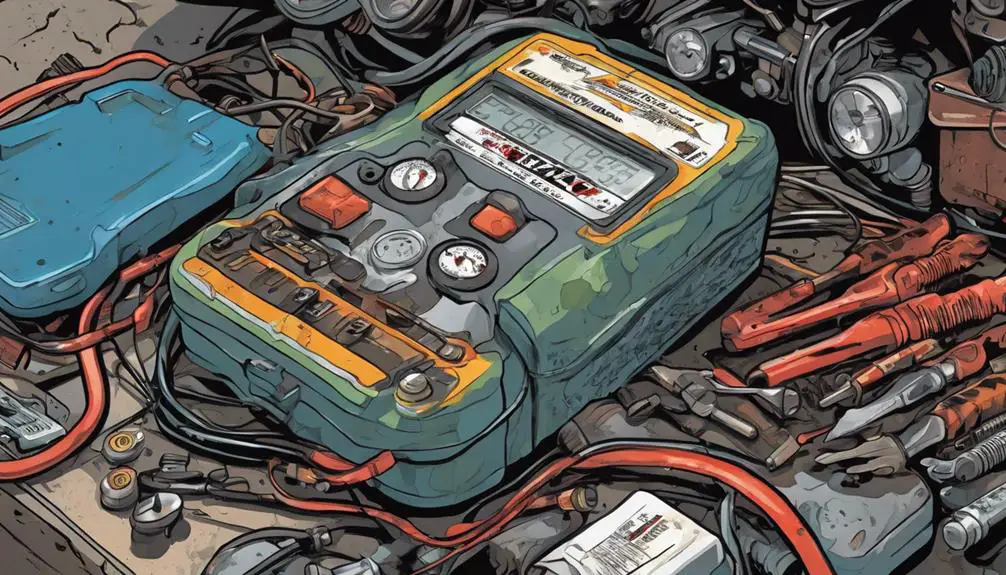
Battery failures are one of the most common electrical issues you'll face on a motorcycle, often leaving you stranded and frustrated. You rely on your bike's battery for starting the engine and powering essential electronics, so when it fails, it can feel like your freedom's been snatched away.
To avoid this situation, keep an eye on your battery's health. Check for corrosion on terminals and verify connections are tight. If your bike struggles to start or you notice dim lights, it might be time for a replacement. Regular maintenance, including charging your battery during long periods of inactivity, can extend its life.
When you do need to replace the battery, choose one that fits your bike's specifications. Consider investing in a high-quality, maintenance-free battery for peace of mind.
And remember, when you're out on the open road, carrying a portable jump starter can be a lifesaver. Staying proactive about your battery keeps you in control, allowing you to experience the thrill of the ride without interruptions.
Embrace your freedom, and don't let battery failures hold you back from the adventures that await!
Wiring Harness Issues
When it comes to wiring harness issues in your motorcycle, you're likely to encounter problems like corrosion and damage, loose connections, and short circuits.
These issues can lead to significant electrical failures if not addressed promptly.
Keeping an eye on your wiring harness can save you from unexpected breakdowns and costly repairs.
Corrosion and Damage
Corrosion and damage in the wiring harness can lead to significant electrical problems in your motorcycle. When moisture and dirt infiltrate the harness, they create a breeding ground for corrosion. This can weaken connections, disrupt power flow, and cause intermittent failures. If you ignore these issues, you might find yourself stranded on the side of the road, waiting for help instead of enjoying your ride.
To liberate yourself from this frustration, regularly inspect your wiring harness for signs of wear and corrosion. Look for frayed wires, exposed metal, or any discoloration that might indicate damage. If you spot corrosion, don't hesitate to clean it off using a wire brush or contact cleaner.
Additionally, consider applying dielectric grease to protect connections from moisture and dirt. This simple step can extend the life of your wiring harness and guarantee you're not left powerless.
Loose Connections
Loose connections in your motorcycle's wiring harness can lead to frustrating electrical problems that disrupt your ride. When wires aren't securely connected, you might experience flickering lights, a stubborn starter, or intermittent power loss. These issues can rob you of the freedom you crave on the open road.
To tackle this, you'll want to inspect your wiring harness regularly. Look for connectors that appear loose or worn out. Often, a simple push or re-seating of the connector can restore your bike's electrical integrity. Don't forget to check the ground connections, too; a poor ground can cause all sorts of chaos.
If you find any damaged wires, it's essential to replace or repair them. Ignoring loose connections can escalate into bigger problems down the line, costing you both time and money.
Short Circuits
Short circuits in your motorcycle's wiring harness can create serious headaches, causing everything from blown fuses to complete electrical failure. When wires rub against each other or come into contact with metal parts, they can create a path for electricity that bypasses its intended route. This can lead to unexpected behavior—like flickering lights, erratic gauges, or even your bike refusing to start.
To liberate yourself from these electrical woes, inspect your wiring harness regularly. Look for frayed or damaged wires, and pay special attention to areas where they might rub against sharp edges or hot components. If you notice any issues, it's best to address them before they escalate into more significant problems.
You may consider using heat-shrink tubing or electrical tape to protect vulnerable wires. In some cases, replacing a damaged section of the harness could be necessary.
Don't hesitate to consult a professional if you're unsure about troubleshooting or repairs. Remember, a well-maintained wiring harness not only enhances your bike's performance but also empowers you to ride freely without the fear of sudden electrical failures.
Faulty Voltage Regulators
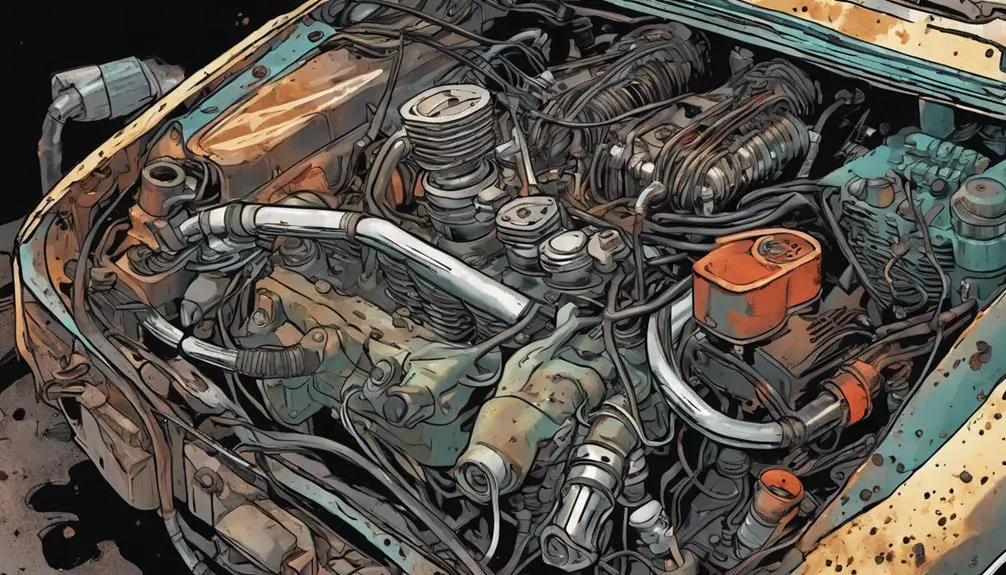
A faulty voltage regulator can lead to inconsistent electrical performance in your motorcycle, causing issues like dim lights and a drained battery. You deserve a ride that feels powerful and reliable, and a malfunctioning regulator can rob you of that freedom. This component's job is to maintain a steady voltage level, preventing overcharging or undercharging your battery. When it fails, you might notice flickering lights or an inability to start your bike after a ride.
To diagnose a faulty regulator, start by checking the battery voltage with a multimeter. If the voltage fluctuates wildly while the engine's running, it might be time for a replacement. Don't ignore those warning signs—your motorcycle's electrical system is essential for your overall riding experience.
When you replace a faulty voltage regulator, you not only restore your bike's electrical integrity, but you also reclaim the joy of riding without constant worry. Invest in a high-quality part to guarantee longevity and reliability. Embrace the open road with confidence, knowing that your motorcycle's electrical system is in its best shape, allowing your spirit to roam free.
Starter Motor Problems
When your starter motor struggles to engage, it can leave you feeling frustrated and stranded, undermining your riding experience. You might be keen to hit the open road, but a faulty starter motor can hold you back. Understanding the common issues can empower you to address them directly.
Here are three common starter motor problems you may encounter:
- Weak Battery: A battery with low voltage can prevent the starter motor from turning over, leaving you stuck as your bike refuses to roar to life.
- Faulty Starter Relay: If the relay isn't functioning properly, it mightn't send the necessary signal to the starter motor, leaving you with silence when you press the button.
- Worn-out Brushes: Over time, the brushes in the starter motor can wear down, causing poor contact and preventing the motor from doing its job.
Being aware of these issues can help you take charge of your motorcycle's health.
With the right knowledge, you're one step closer to freedom on two wheels, ready to conquer the roads ahead.
Electrical Short Circuits
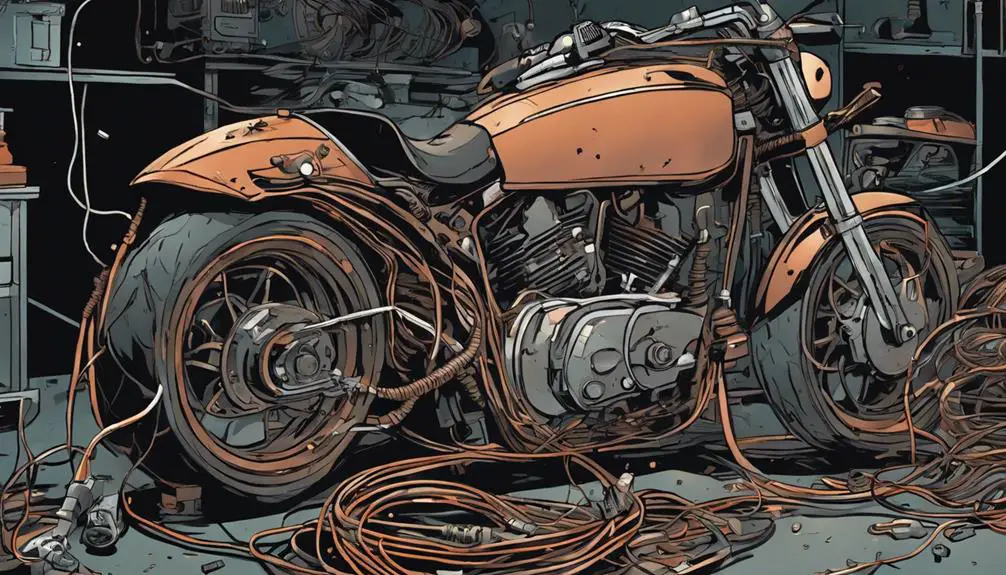
Electrical short circuits can lead to unexpected power failures and even pose safety risks, making it essential for riders to recognize the signs early.
When wires fray or connections loosen, the electric current can take unintended paths, causing your bike to behave erratically or refuse to start. It's more than just an inconvenience; it can compromise your freedom on the road.
Watch for flickering lights, sudden drops in power, or strange smells coming from your electrical components. If you notice any of these signs, it's vital to address the issue before it spirals into a bigger problem.
Checking your wiring harness and connectors regularly can help you catch issues before they escalate.
Don't let an electrical short circuit clip your wings. You deserve the thrill of the ride without the fear of breakdowns.
If you suspect a short, consider consulting a qualified mechanic to get to the root of the problem. They can help you restore the electrical integrity of your motorcycle, ensuring you can ride freely and confidently.
Keep your bike in top shape, and let nothing stand in the way of your adventures!
Ignition Coil Malfunctions
Ignition coil malfunctions can disrupt your motorcycle's performance, leaving you stranded and frustrated. When your ignition coil isn't firing properly, you're in for a rough ride. You might notice symptoms like rough idling, difficulty starting, or a complete loss of power. These issues can rob you of the freedom you crave while riding.
To help you identify potential ignition coil problems, look for these telltale signs:
- Weak or No Spark: If your spark plugs aren't igniting, your engine won't roar to life.
- Backfiring: A popping sound from your exhaust indicates the fuel isn't being ignited at the right time.
- Increased Fuel Consumption: If you're filling up more often, your ignition coil might be struggling to deliver the spark needed for peak combustion.
Don't let ignition coil malfunctions keep you from the open road. Regularly check your motorcycle's electrical components, and if you suspect a problem, address it quickly.
Flickering Lights
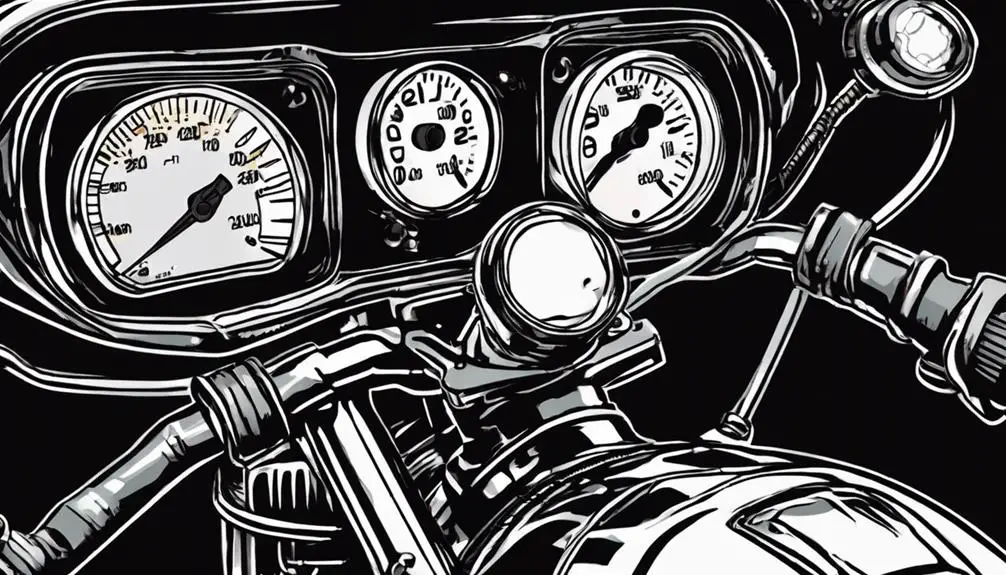
Flickering lights on your motorcycle can signal underlying electrical issues that need your immediate attention. If you notice your headlight or taillight dancing in and out, it's more than just a flicker; it's a call for action. This could point to a loose connection, frayed wiring, or a failing component in your electrical system. Ignoring these signals can lead to bigger problems down the road, compromising your freedom on the open road.
Start by checking the connections at the bulbs. Loose or corroded terminals can disrupt the flow of electricity, causing those annoying flickers.
Next, inspect the wiring harness for any signs of wear or damage. If the wiring looks good, consider the possibility that your voltage regulator might be struggling to maintain consistent power.
Don't let flickering lights dim your ride. Your motorcycle deserves the freedom of reliable lighting, ensuring not only your safety but also your ability to express your true self on two wheels.
Take the time to address this issue, and you'll ride with confidence, knowing your bike is in top shape and ready for any adventure that awaits.
Blown Fuses
Blown fuses can leave you stranded and signal that something's gone awry in your motorcycle's electrical system. When a fuse blows, it's a protective measure that prevents further damage.
But what could cause this disruption? Here are three common culprits you should keep an eye on:
- Overloaded Circuits: Too many accessories drawing power can push your system past its limits. Think about that extra phone charger or heated grips you added.
- Short Circuits: Worn wiring or accidental contact can create a short, causing the fuse to blow and leaving you in the lurch. You wouldn't want a frayed wire ruining your ride.
- Faulty Components: Sometimes, a malfunctioning part—like a headlight or starter motor—can draw excessive power and lead to a blown fuse. It's crucial to catch these issues early.
To maintain your freedom on the open road, regularly check your fuses and wiring. If you find a blown fuse, replace it and investigate the root cause. Ignoring the signs can lead to more significant problems, so stay vigilant and keep your ride exhilarating!
Corroded Connectors
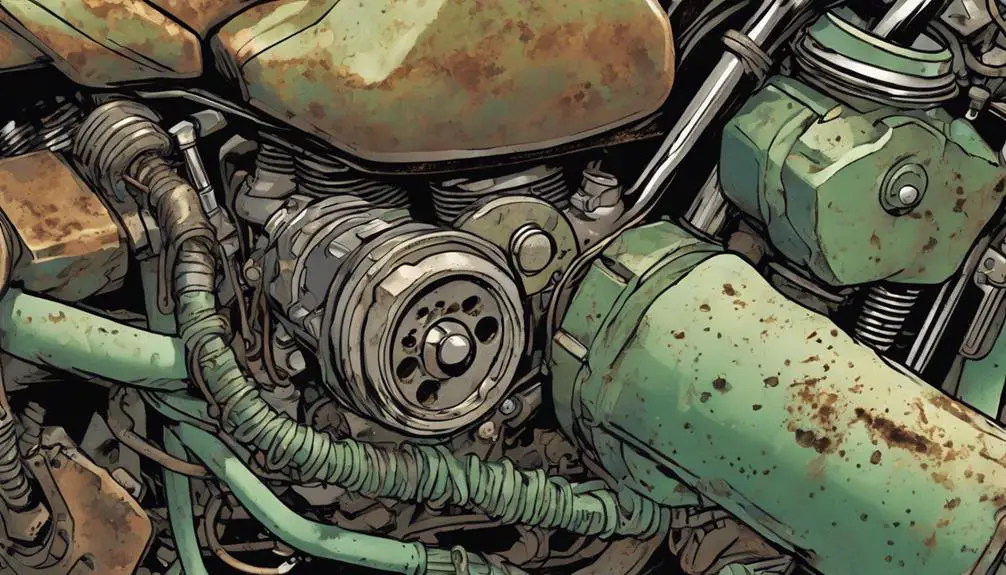
Corroded connectors can disrupt your motorcycle's electrical flow, leading to performance issues and unexpected breakdowns. When you ride, you're seeking freedom, and nothing should hold you back. Corrosion often sneaks in unnoticed, usually due to moisture or dirt, and it can create resistance that slows down the electrical current. This can manifest as dim headlights, weak signals, or even complete loss of functionality in certain systems.
To reclaim your ride, regularly inspect the connectors. Look for any signs of green or white buildup, which indicates corrosion. If you spot it, don't hesitate to clean it off using a wire brush or a specialized connector cleaner. Make certain to dry the area thoroughly afterwards.
You might also consider applying a dielectric grease to the connectors after cleaning. This can create a protective barrier against future moisture and dirt. Remember, a well-maintained electrical system means a smooth ride, letting you feel the wind in your hair without worries.
Embrace the open road and verify your connectors are in top shape, so you can ride freely, knowing you're one step closer to that exhilarating sense of liberation.
Dashboard Indicator Errors
Dashboard indicator errors can signal underlying electrical issues that may affect your motorcycle's performance. When those lights flash unexpectedly, it's your bike's way of communicating that something's amiss. Ignoring these warnings can lead to a ride that's less than liberating.
Here are three common dashboard indicators you might encounter:
- Battery Warning Light: This light flickers when your charging system isn't functioning properly. A weak battery can limit your adventures.
- Oil Pressure Light: When this indicator shines, it could mean your oil level is low or there's a more serious issue at play. Keeping your engine lubricated is key to freedom on the road.
- Check Engine Light: This light can indicate various problems, from minor issues to serious faults. It's the motorcycle's way of urging you to inspect your ride before setting off.
Addressing these dashboard errors promptly will help you reclaim the joy of riding without the nagging worry of potential breakdowns.
Frequently Asked Questions
How Can I Prevent Electrical Issues in My Motorcycle?
To prevent electrical issues in your motorcycle, you've gotta stay proactive.
Regularly check your battery connections, ensuring they're tight and corrosion-free.
Keep your wiring harnesses intact and inspect for fraying or damage.
Clean your bike's electrical components, and consider using a battery maintainer during off-seasons.
Don't forget to replace old or worn-out fuses and bulbs.
Embrace routine maintenance, and you'll ride with confidence, free from unexpected electrical headaches!
What Tools Do I Need for Basic Electrical Troubleshooting?
For basic electrical troubleshooting, you'll need a multimeter to measure voltage, resistance, and continuity.
A wire stripper and crimping tool help with connections, while insulated screwdrivers keep you safe.
Keep a flashlight handy to illuminate tight spaces.
You'll also benefit from electrical tape and zip ties for securing loose wires.
Can Weather Conditions Affect Motorcycle Electrical Systems?
Weather's like a wild card in the game of motorcycle riding. Rain, humidity, and extreme temperatures can play havoc with your electrical systems.
Moisture can cause short circuits or corrosion, while freezing temps might drain your battery faster than a speeding bike.
To keep your ride smooth, you've gotta protect those electrical components and guarantee connections are tight.
Embrace the elements, but don't let them ride roughshod over your motorcycle's performance!
How Often Should I Inspect My Motorcycle's Electrical Components?
You should inspect your motorcycle's electrical components at least once a month, or more frequently if you ride often.
Regular checks help you catch potential issues early, keeping your ride smooth and safe.
Don't forget to look at the battery, wiring, and connections, especially after long trips or harsh weather.
Staying on top of these inspections empowers you to maintain your freedom on the road without unexpected breakdowns.
Are There Any Warning Signs of Impending Electrical Failure?
Ever felt that twinge of uncertainty when your ride's not performing right? You might notice flickering lights, sluggish starts, or strange noises—these are your bike's way of screaming for help!
If you catch your battery warning light flickering or if your electrical components act erratic, don't ignore it. Trust your instincts; they're your best guide.
Keep an eye out for these signals, and you'll keep your freedom on the open road intact.
Conclusion
In summary, staying on top of your motorcycle's electrical health is essential for a safe ride.
Did you know that nearly 30% of motorcycle breakdowns are due to battery failures?
By regularly checking your battery, wiring, and connections, you can greatly reduce your chances of being stranded.
Remember, a little maintenance goes a long way in keeping your bike running smoothly and ensuring you enjoy the open road without unexpected electrical issues.